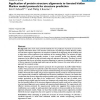508 search results - page 26 / 102 » A graphical model for protein secondary structure prediction |
CIKM
2009
Springer
14 years 2 months ago
2009
Springer
Background: Although both conservation and correlated mutation (CM) are important information reflecting the different sorts of context in multiple sequence alignment, most of ali...
BMCBI
2006
13 years 8 months ago
2006
Background: One of the most powerful methods for the prediction of protein structure from sequence information alone is the iterative construction of profile-type models. Because ...
BMCBI
2004
13 years 7 months ago
2004
Background: Because loops connect regular secondary structures, analysis of the former depends directly on the definition of the latter. The numerous assignment methods, however, ...
AE
2005
Springer
14 years 1 months ago
2005
Springer
This paper presents an enhanced genetic algorithm for the protein structure prediction problem. A new fitness function, that uses the concept of radius of gyration, is proposed. Al...
BMCBI
2008
13 years 8 months ago
2008
Background: Protein domains are the structural and functional units of proteins. The ability to parse proteins into different domains is important for effective classification, un...

